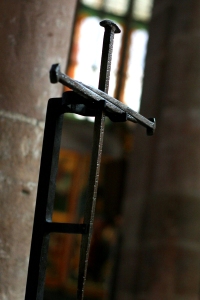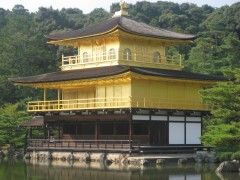Pilgrimage to nowhere
April 15, 2012
On a recent visit to the British Museum’s fascinating and admirable Hajj exhibition I was particularly struck by some images by the Saudi artist Ahmed Mater showing iron filings bending towards a powerful magnet, suggestive of the faithful circling the Ka’ba. A sense of the life force itself at its most fundamental physical level being drawn to the sacred object.
(Philosophically, I think the irresistible attraction of iron and magnet and the force of human will (to survive, to act, to desire, to create) are closer than they might at first seem.)
My response to the Hajj is of both attraction and repulsion. I’m attracted to the strong sense of community, to the emotional force that arises from shared ritual, and to the idea of an arduous journey being a condition of great reward. But I’m also repelled by the sense of a vast volume of people with their collective power and will, and by the idea of sacred obligation or prohibition.
I came out of the exhibition feeling that I would very much like to have the possibility of something like the Hajj in my life, but that I basically want to have my cake and eat it: to be able to share in some kind of profound sacred journey, yet be completely free to choose how I participate.
So what could pilgrimage mean for a non-religious, strongly individualistic, modern European?
We speak of all sorts of things in contemporary life as pilgrimages – artistic, musical, historical, mystical, gastronomic, retail – including various types of inner journey. But I always have the feeling that these are at least in part just metaphor. (And the word ‘Mecca’ of course has been completely trivialised in English right down to being a grubby brand of bingo.) I want the real thing.
To paraphrase various dictionary definitions, a pilgrimage is normally thought of as “a journey of great spiritual significance, typically to a religious shrine”. The journey part is easy enough to understand, but ‘spiritual’ and ‘shrine’ are both problematic. And there is also a fourth element to think about that seems to me implied though not stated in definitions: that there is something collective about the experience or at least its motivation.
The journey
Going on holiday is not pilgrimage. It has to be more than that – though I don’t doubt that in most traditions pilgrimage has an element of fun, of play, that overlaps with the contemporary idea of a holiday.
But travel is an essential element of pilgrimage, and to me the idea of that travel being really challenging is central to the sense of heightened emotional significance I would expect. Many traditions see repentance as an essential part of pilgrimage. I don’t, but the ordeal of long travel fits nicely into that.
Walking half way across the country to a cathedral, climbing to a high mountaintop, crossing a desert – these kind of ordeals make total sense to me as a way in to a very special experience. Tourists try to access this feeling by, for example, walking to Machu Picchu. The Burning Man Festival is placed far away from civilisation in a maximally inhospitable place in part to create a sense of achievement in getting there.
The spiritual experience
My social circle seems divided into people who use the language of spirit a lot and those who basically find it embarrassing or laughable. Personally I think of ‘spiritual’ as one of those words (like perhaps ‘terrorist’ and ‘feminism’) that has been so stretched and drained of meaning as to be pretty useless, though I’m fairly comfortable using it as a kind of sloppy shorthand – for something, I don’t know quite what – if I’m pushed.
I was once put on the spot in a workshop and asked to talk about ‘spirit’ for three minutes! I decided that for me it’s not really separate from emotion – it’s simply the top slice of emotional feeling (in terms of depth and significance, not intensity). I’ve also been toying lately with the definition that the spiritual is “where philosophy meets emotional force”.
Obviously for religious people that means religion. And for people with strong belief systems that don’t fit into traditional religions there are clear places to look for the spiritual element in life.
For me it’s less clear, but there are certainly a few things in my life that sit in that space. Much of that is around art, music and literature. I sometimes wonder if worship is basically the same as art. When I attend a performance of, for example, music by Bach, it seems to me that I am doing something very similar to going to a church service. There are also things I do – dance, meditation, just being with nature – that take me into those same deep areas of reflection and connection.
So I do (sort of) know what it means for an experience to have spiritual force – and that is what I would be looking for as the goal of a pilgrimage.
The sacred shrine
This is where things get difficult. I love the idea of, say, Canterbury Cathedral as a destination. It’s very big and very old, with a massive collective history and physical presence. It’s a great focus for a long walk, and seeing it on the skyline for hours before arrival would be deeply exhilarating.
I would genuinely love walking to Canterbury, and I’m sure I would find it a very moving experience.
But, just as if I did a Richard Burton and attempted the Hajj in fancy dress, I would feel, at least in part, that I was piggybacking another community’s rituals. I’m not authentically part of that world for which Canterbury is a spiritual home, and it would have a distinct element of exotic tourism.
In the absence of organised religion, finding a potent physical destination for a spiritual journey is very problematic. In the age of communism phoney political shrines were developed to tap into the communal power of pilgrimage. For some people scenes of battle might play this role. For me the possibilities I have considered are artistic and natural.
Places associated with great artistic endeavour, such as birthplaces and deathplaces, are plentiful, and from a practical point of view can easily be made into destinations. The journey would have to be strongly focused on the specific destination, and not just be a holiday including dropping in at someone’s house as an afterthought. The Bach Cantata Pilgrimage of John Eliot Gardiner took this idea to another level, going way beyond simply visiting the Thomaskirche in Leipzig and other major Bach related places.
But I do have a certain discomfort at treating such places as shrines, with holy relics of old pianos and paintpots and fountain pens. These were people after all. Nothing supernatural. I love them because I relate to them as real individuals who lived and worked and loved and sinned.
Natural wonders are also attractive for great journeys, and again I’m sure I could devise very powerful experiences around them. But still it would only really be analogous to a pilgrimage, not quite the real thing, unless I was part of some community with a special relationship to place – e.g. perhaps native peoples around Uluru or the Grand Canyon. But I’m not. In my world those places may be awe-inspiring and even elicit spiritual depths, but visiting them remains only somewhat like a pilgrimage. This lack of collective relationship to place leads me onto the final topic.
The community of pilgrims
For me I think pilgrimage fundamentally has to be a shared experience. Not necessarily as strongly collective as the Hajj, with everyone congregating at the same time for the same rituals, but at least in the sense of there being a shared goal, a shared purpose, within a community. I guess my ideal is something like the Canterbury Tales. And this is the biggest problem for me in finding something that can be considered a pilgrimage.
Discussing this with friends over the past weeks I’ve noticed that people find it easier to adapt the concept of a retreat to modern secular life, and I think one of the reasons for that is that it’s something you can plan entirely according to your own needs and potentially without the involvement of a community. A solitary week in the mountains of Wales with a sketchbook and pen is absolutely a retreat, not just a bit like a retreat. It’s a physical displacement from everyday habits that has the potential for exceptional meaning and depth.
So my conclusion has to be that only various partial approximations to pilgrimage are available to me. I can’t combine all four of the above criteria in a meaningful authentic way – at least not where I am in my life now.
I would love to have my own community with its own rules and celebrations and places to venerate. I’m not going to create my own religion. But in time that community may yet emerge, in a modest, personal way.
– – – –
Bayreuth?
Apart from the exhibition, the other reason I’ve been thinking about pilgrimage is that last summer I travelled with some friends to my first Bayreuth Festival.
I was determined not to see the trip in tiresomely mystical terms. Wagner fanatics can be terribly excessive, and for me moving away from that sort of hero worship has been part of growing up.
But the feeling of pilgrimage crept up on me, unanticipated, once I arrived. Something about the collective purpose of so many people present in that place, including the collective purpose of my own little group, plus the particular seriousness and personal significance of the work itself, combined with the presence of the Wagner house – and especially the Wagner grave, with its attendant mood of silence and reflection.
I think it may be the nearest thing I’ll get.
I suspect I’m being overly delicate in resisting the parallel between artistic and religious shrines. In many traditions hundreds of individuals are held up for admiration and celebration – saints, bodhisattvas, etc. – not to mention the gods of the ancient world. If I stop trying to be cool about it, avoiding cheesy hero worship at all costs, not wanting to be the person crawling on hands and knees to Graceland … well, there’s no doubt that I really do have these figures in my life, and they are very significant for me. In the same way as saints? Perhaps.